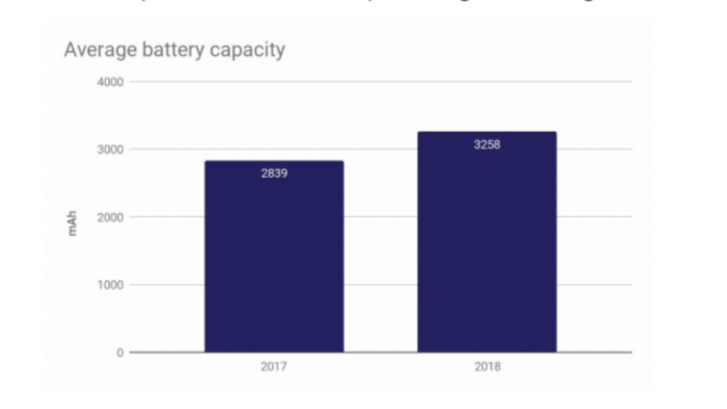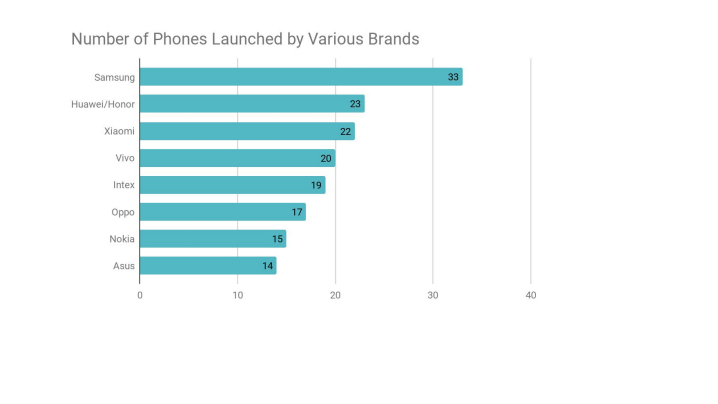Smartphone trends in India 2018: Around 92% of phones had a taller display and thin bezels
The year 2018 has gone by, and it’s fair to say it was one of the most interesting years for smartphone lovers in India. While high-end phones became cheaper, premium handsets inched closer to Rs 1.5 lakh mark. Notch, among the key trends, was joined by the use of glass on the body. More phones ditched headphone jack, truly bezel-less phones became a reality, the in-display fingerprint is now a thing, and the power of AI still finds itself limited to the camera.
We saw phones with three and four cameras in a market where the best-rated camera phone still uses a single lens. Apple completely ditched the home button and phones across price range now have facial recognition. On the whole, we saw some more marketable features and design innovations on some phones in the flagship segment, but it was even better for India’s most populated under Rs 20K smartphone segment. We witnessed a great comeback from Asus with its Max Pro series, and new brands like Realme and Nokia gave tough competition to segment-leader Xiaomi.
By the end, we got a taste of gaming smartphones like the Asus ROG Phone, which might leave a mark in history as it is the first true gaming phone to be launched in India.
While we were busy reviewing the crazy number of phones released in 2018, our friends at Phonecurry did some counting for us in their year-end data report. The report gives insights into the consumer and producer trends followed by the mobile phone industry in 2018.
More phones under Rs 20K
We all know that India is a hot market for phones ranging from Rs 10K-20K, and unsurprisingly, about 75% of all the smartphones launched last year were below Rs 20,000 mark. We saw an aggressive approach from OEMs like Asus, Honor, Nokia, Realme to catch up with Xiaomi in the affordable segment.
While phones like Xiaomi Mi A2 and Redmi Note 5 Pro had a dominating start, alternatives like Asus Zenfone Max Pro M1, Nokia 6.1 Plus and Realme 2 Pro gave serious competition to the market leader. Asus transformed its ZenUI in favor of a stock UI, which eventually worked for the brand. Moto wasn’t as strong a player as it was a year ago, but it ended the year with Moto One Power, a promising device that joins the Android One league.
A bigger, longer screen was favored by OEMs

The most inevitable trend was the notch, that came bundled with the idea of the highest possible screen to body ratio. As a result, about 61% of phones were launched with a screen size of 5.6-inch and more. The aggressive bezel-chopping also led to a complete take-over from 16:9 aspect ratio to 18:9 and more. Around 92% of phones had a taller display and minimal bezels.
An average of 10 percent increase in battery capacity

OEMs have realized the need for a bigger battery on phones, hence we saw about 10% increase in battery capacity on an average across segments. Also, about 90% of phones above Rs 30K have shifted to USB Type-C standard. The better part is that bigger batteries did not affect the form factor and design. A good example is the Samsung Galaxy Note 9, which packs a huge 4000mAh battery in a fairly sleek shell with weight distributed evenly.
Moreover, about 70% phones between Rs 20K-30K had 'Quick Charging' and all the phones above Rs 30K had their versions of fast charging.
Samsung released most phones

Of all the manufacturers, Samsung remained the one with the most number of handsets released across all price segments. Even globally, a report by IDC states that Samsung shipped 72.2 million smartphone units around the globe, representing a 13.4 percent decline from its Q3 2017 results.
A lot more happened in the Indian smartphone market, where we saw the popularity of iPhones decline, and ‘good camera’ is still the most important quality factor consumers looked for.
Another great year for Chinese OEMs
Chinese brands continued to dominate with Xiaomi being the most popular name among Indians and OnePlus turned out to be the highest rated brand. Both brands have one thing in common -- the quality of products and value. Speaking of China, there are some names that deserve a special mention. Phones like Oppo Find X, Vivo Nex and Mi Mix 3 (not launched in India) showed us a glimpse of the future of phones. They were the first to come up with a practical workaround for a completely bezel-less front design.
In 2019, we expect this quality and value proposition to meet innovation with the power of 7nm chipsets, and hopefully 5G. Until then, we already have a lot to look forward to; foldable phones, gaming smartphones, pinhole cameras and what not.
Disclaimer: The report by PhoneCurry covers brands ranging from Xiaomi, OnePlus, Samsung to smaller players like LeEco, InFocus, Smartron, LYF and more. It also uses behavioral mapping of more than 2 Million users for statistical analysis.
- Not happy with what 2018 served? Here are 10 smartphones launches to look out for in 2019.
Contributer : Techradar - All the latest technology news http://bit.ly/2SxfqvD

 Reviewed by mimisabreena
on
Thursday, January 03, 2019
Rating:
Reviewed by mimisabreena
on
Thursday, January 03, 2019
Rating:














No comments:
Post a Comment